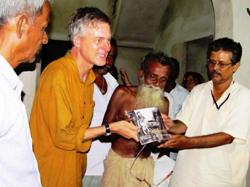 Nigel Hughes tells Sarah Day about a pioneering Earth science outreach project in Bengal, India.
Nigel Hughes tells Sarah Day about a pioneering Earth science outreach project in Bengal, India.
‘Gatchpathor’ are a strange, yet familiar sight through much of Bengal. With clearly preserved fibres and rings suggestive of wood, their weight and composition that of rock, they have long been the object of religious and cultural traditions that attempt to explain their origins. They have been called the bones of a ‘Bokashur’ demon, or objects turned to stone by the actions of a local Pir (Muslim saint).
In fact, they are petrified wood. Permineralisation has replaced the organic material, preserving the original structure of the plant over millions of years. Now, they are the focus of an unusual collaboration between scientists, artists and others concerned with improving the educational and social opportunities in rural communities in Paschim Banga (West Begnal).
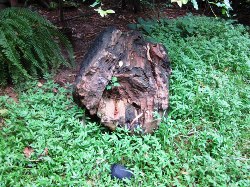 With literacy in the rural schools of Paschim Banga (West Bengal) improving all the time, children now have access to a whole new array of sources. This development has made it possible to create a children’s book, with the aim of introducing scientific thinking about Earth history.
With literacy in the rural schools of Paschim Banga (West Bengal) improving all the time, children now have access to a whole new array of sources. This development has made it possible to create a children’s book, with the aim of introducing scientific thinking about Earth history.
‘Monishar pathorer bon’ (Monisha and the stone forest) introduces basic principles of historical geology as revealed to a bright and curious village girl in her quest to find a natural explanation for gatchpathor. Aimed at children aged 11-17, the story follows Monisha as she searches for answers, using a series of settings familiar in the lives of children in rural Bengal; wandering folk musicians, a wedding, rides on the top of buses, local hot springs.
Inspired by the Geological Society of India’s outreach mission to school students in regional languages, the book is illustrated by Patha Bhavana art teacher Rati Basu. Thanks to financial support from other professional geological societies in the UK and USA, including the Geological Society of London, the Palaeontological Association and the Palaeontological Society, it has been possible to make three thousand copies of the Bengali version freely available to students.
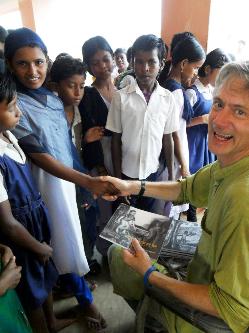 An important message in the book is that Monisha is the agent of her own discoveries and their interpretation. She does not rely on received knowledge from external sources, and though she receives guidance about how to observe and think rationally, she is not told what to think or what to look at. She devises her own ‘dekho, bhabo, aber dekho’ approach of looking, thinking and then looking again at the world around her, making a series of discoveries of increasing insight until finally, she glimpses a comprehensive understanding of the past. Monisha is rewarded for her efforts by a vision of Bengal as it was five million years ago, at the time that the gatchpathor were living trees.
An important message in the book is that Monisha is the agent of her own discoveries and their interpretation. She does not rely on received knowledge from external sources, and though she receives guidance about how to observe and think rationally, she is not told what to think or what to look at. She devises her own ‘dekho, bhabo, aber dekho’ approach of looking, thinking and then looking again at the world around her, making a series of discoveries of increasing insight until finally, she glimpses a comprehensive understanding of the past. Monisha is rewarded for her efforts by a vision of Bengal as it was five million years ago, at the time that the gatchpathor were living trees.
INTEREST
Beyond its scientific message, the story celebrates the diversity of peoples and religious traditions that characterise the area, comments on local environmental modification by human activity, and on social relationships between rural and city-based communities. By developing the story in a setting familiar to its intended audience, the book aims to spark bright children’s interest in local environmental history, and to give them a sense of agency in understanding and interacting with the world around them.
 In August 2012, a team including the book’s authors, two female undergraduate students of Bengali origin from the University of California and local folk singer Bipod Tarun Das Baul (who features in the story) undertook a two-week campaign to promote the book. They visited institutions in six blocks within Birbhum and in Bardhamun, ranging from university classes, madrassehs and high schools, through Madhyamik Shiska Kendras (higher level educational centres), to NGO-sponsored schools. A particular focus was placed on schools with children from economically and socially disadvantaged backgrounds.
In August 2012, a team including the book’s authors, two female undergraduate students of Bengali origin from the University of California and local folk singer Bipod Tarun Das Baul (who features in the story) undertook a two-week campaign to promote the book. They visited institutions in six blocks within Birbhum and in Bardhamun, ranging from university classes, madrassehs and high schools, through Madhyamik Shiska Kendras (higher level educational centres), to NGO-sponsored schools. A particular focus was placed on schools with children from economically and socially disadvantaged backgrounds.
As well as distributing the books, we made presentations to groups of students, in which specimens of gatchpathor were made available for the children to inspect and feel, and its characteristics discussed in an interactive way. Through this, the story and the process of fossilisation were introduced. We used colour pictures of animals which would have been living in Birbhum five million years ago, as reconstructed from fossils known mostly from the sub-Himalaya, and contrasted them with their living relatives, demonstrating how change in animal form has occurred over time. With music an important educational medium throughout Bengal, songs associated with the story were also performed.
The presentations reached around 2500 children, and generated much interest and discussion. There were excellent questions, particularly from female students. Perhaps most encouragingly, we have begun receiving reports that several new discoveries of gatchpathor have been made by students stimulated by the book, and of students conducting field trips to sites mentioned in it, on their own initiative.
Additional copies of the book are now being distributed across West Bengal via organisations dedicated to informal science education, and plans are in progress for follow-up sessions in Birbhum and further distribution in Bangladesh in 2013. The Geological Society of India will be sponsoring a Hindi version of the book, to be distributed in other parts of India. An important message of the book is that fossils such as the gatchpathor are the heritage of everyone – it is not necessary to be wealthy or educated to appreciate and understand their significance. We hope that the book’s success will help to pass this message on to many more students in the future.
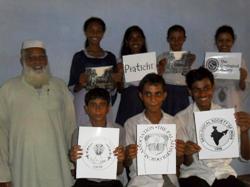 Credits
Credits
The book was inspired by the Geological Society of India’s outreach mission to school students in regional languages, and specifically derives from experiences and friendships made in the 1980s at Nobel prize winning poet Rabindranath Tagore’s university Visva Bharati at Santiniketan, which is located in Birbhum district.
The style and presentation of the book and its illustrations, which are by Patha Bhavana art teacher Rati Basu, reflect Santiniketan’s tradition of informal and creative collaborations, and was particularly inspired by long time Santiniketan resident and social activist Shyamali Khastgir, to whose memory the book is dedicated.
The occurrence and significance of the gatchpathor has been highlighted by important published work on the geological setting of these fossils by local geologist Urmila Ganguly. The author of the story, Nigel Hughes, is also a professor of Geology at the University of California, Riverside, and researches in India, though not specifically on gatchpathor.
During the development of the story many specialists, both within India and abroad, were consulted and all offered their advice freely. Translation was by Dipen Bhattarcharya, professor of physics in the Riverside Community College system, and book layout was by Pulak Dutta, who teaches graphic art in Kala Bhavan, Santiniketan.
Distribution was achieved through a partnership with the Pratichi Trust (primarily thanks to Kumar Rana) and with local teachers in Birbhum district (particularly through the efforts of Manisha Banerjee).
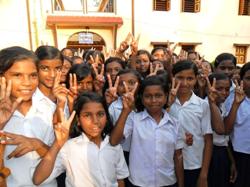 Thanks to sponsorship, four thousand copies of the Bengali version have been made available for free distribution. Some three thousand of these have been distributed, partly through the Science Communicators’ Forum, the West Bengal Teachers’ Association, the West Bengal Primary Teachers’ Association and the Suri-based Institute for the Development of Educational Activities (IDEA).
Thanks to sponsorship, four thousand copies of the Bengali version have been made available for free distribution. Some three thousand of these have been distributed, partly through the Science Communicators’ Forum, the West Bengal Teachers’ Association, the West Bengal Primary Teachers’ Association and the Suri-based Institute for the Development of Educational Activities (IDEA).
The Bengali version of the book is published by Monfakira Press in collaboration with the various professional sponsors, and is available for sale at www.monfakira.com. The English version is published by the Geological Society of India at www.geosocindia.org, also with the financial assistance of the various professional organizations listed above. Profits will support further outreach activities by the Geological Society of India.
* Nigel Hughes is Professor of Paleobiology at the Deptartment of Earth Sciences, University of California, Riverside CA 92521 E: [email protected]
For more information, pictures and video, please log onto Facebook and search for (and Like!) ‘Monishar Pathorer Bon’.